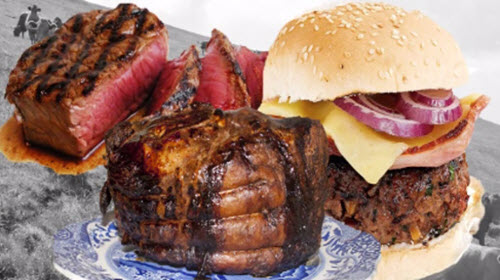
Cattle provide us with meat, milk, leather, glue, gelatine to name a few items, and in some countries they are still used for draft. Here we look at beef cattle kept for their meat.
In some countries beef and milk is produced from the same animal, this is called a dual purpose breed. In other countries, like North America, the beef and dairy cattle are completely independent sectors.
The cattle industry in the UK is divided into these two main sectors, however there is an intimate relationship between the two. The beef produced in this country comes partly from the dairy herd, which is primarily kept for milk, and partly from the suckler herd which is purposely kept for meat production. The intimate relationship comes from the important exchange of breeding stock between the suckler and diary herds. This food story looks at the beef or suckler cow sector of UK Agriculture
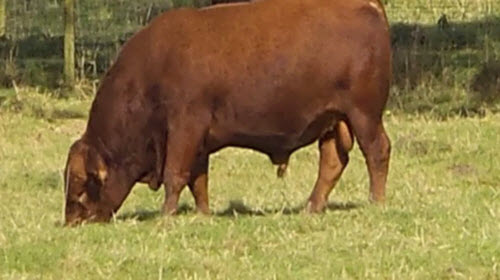
Billy Bull
A bull is a male cow ( a female is called a cow!) If you see a field of cows and there is a bull in the field with them then he will usually be the largest animal in there. The best way to see a bull is from at distance or on our video as they can be very dangerous, as can cows especially if they have young calves and they feel you are a threat, especially if you are walking your dog! Because they can be dangerous they often have a ring through their nose so the farmer can have some control over them.
Cows will only mate with a bull at certain times – farmers say they are in season or on heat. The bull can tell this by sniffing the air or the cows wee which contains special chemicals called pheromones which tell the bull the cow is ready to mate.
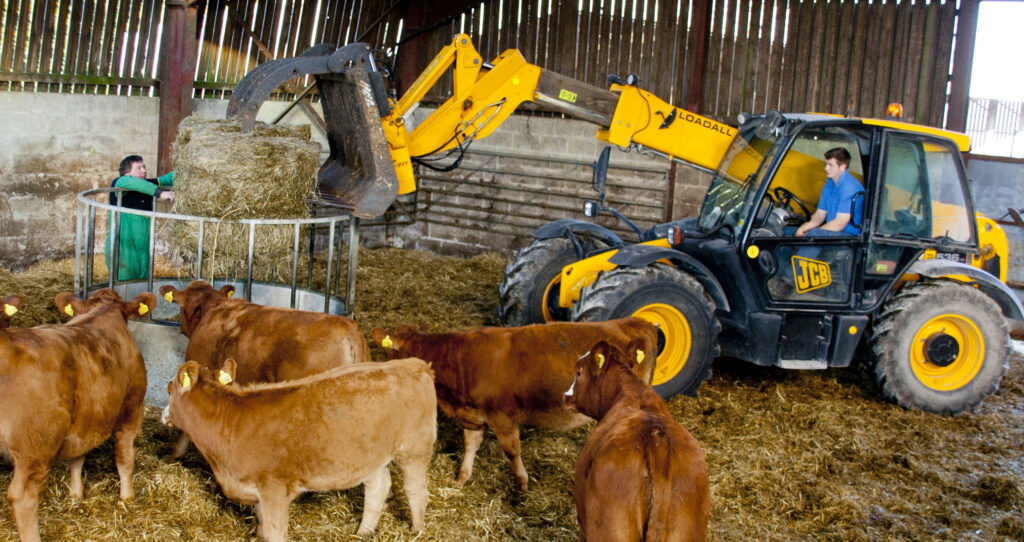
Housing Cattle
Video shows cattle being brought in for the winter.
Since BSE all cattle for human consumption must be slaughtered under 30 months old. This has had an effect on how beef cattle are reared since they must be grow to a suitable weight and condition for slaughter by this age. To ensure this is the case many cattle are now housed in winter. Housing cattle over winter also has other advantages:
- It stops them damaging or ‘poaching’ the pastures in the fields where they would be kept, in some cases the fields became so churned up and muddy that they need replanting and the cattle’s feet could also suffer from foot rot and other problems.
- It allows the cattle to be finished for slaughter by feeding them specially prepared rations easily.
- It allows sufficient grass to grow so that cattle can be finished for slaughter the following summer.
Cattle are housed in purpose built sheds or just suitably adapted ones.
Housed cattle easier to feed, water, bed up (give fresh clean straw), and generally look after. A good stock person checks on the cattle several times each day. It also makes monitoring calving much easier. Cattle kept inside do require more work. Every few days they must be ‘bedded-up’ this means giving them clean straw so that they have a clean, healthy home to live in. The cattle love the clean straw……
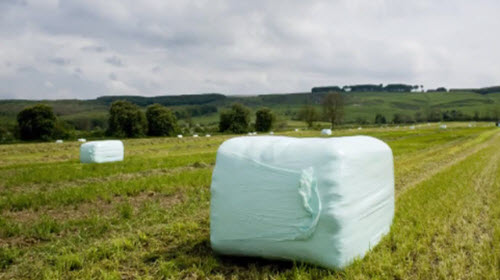
Preserving Grass
Silage is ‘pickled’ grass basically the grass is placed in a clamp or more commonly now wrapped in plastic like in the video. This removes the air and means that the bacteria which would cause rotting – like with your grass cuttings, cannot function. Instead a different type of bacteria work on this grass converting the sugars in the grass to acid and effectively pickle it – sometimes the cut grass is inoculated with this type of bacteria to promote the correct type of fermentation.
Cattle are usually fed silage and perhaps some concentrates which are things like barley, soya or other by-products like sugar beet pulp, brewers grains etc. The cattles’ food or ration maybe mixed in a special machine called a ‘feed or mixer wagon’. This machine allows farmer to weigh and mix different ingredients together. The cattle are then fed this balanced ration. A bit like ‘fast food’ gone LARGE, the cattle love it and gobble it up!!
Most beef is produced in this way using a combination of grass, included preserved grass like silage and hay, and concentrates (barley, soya beans etc). The cattle may be finished inside over their second winter at around 18 months of age, or turned out to finish on grass during their second summer. These cattle are slaughtered any where from 18 – 30 months old at a weight of 450 – 550 Kg.

Calving
Cows usually all calve around the same time on a particular farm – either Autumn or Spring. Farmers will often bring the cows inside to do this so they are easier to watch and help if they get into difficulties. Some cows do calve outside – if you are ever out walking and see a cow you think may be calving you should keep well clear as you may disturb here and she could also be very aggressive.
Beef cattle tend to be referred to as calves until they are 6-9 months of age when they are weaned. This process is called rearing. After weaning these cattle are generally referred to as stores.
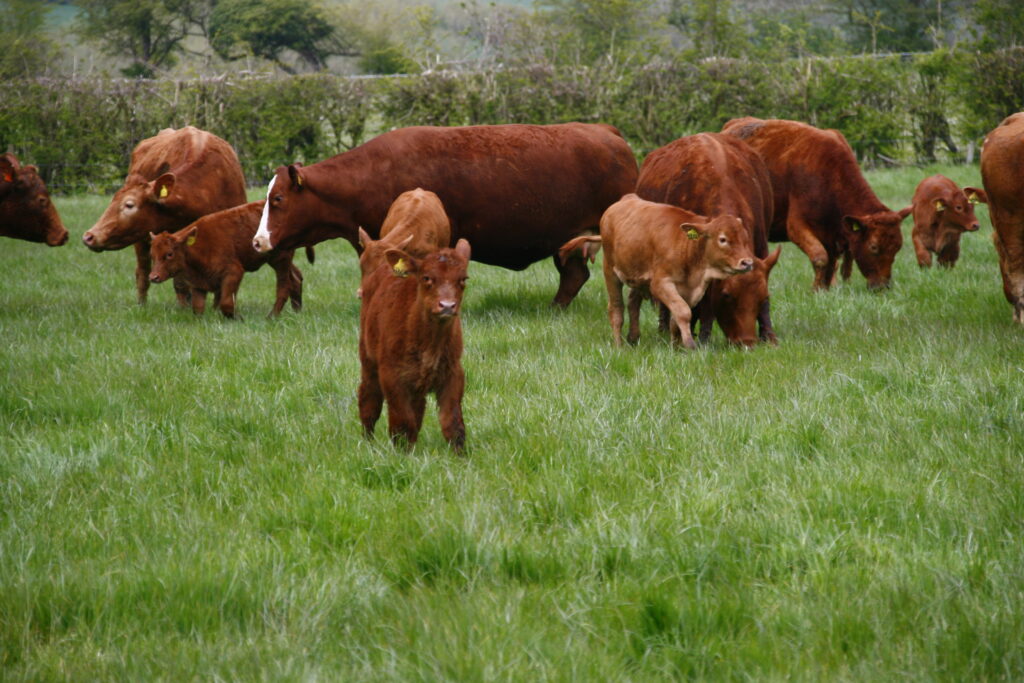
Turning Cattle Out
Having been housed over winter cattled are ‘turned out’ at spring back into their fields.
The farmer will manage his grass fields to get the most out the land he has available.
This will include applying fertiliser and saving some field to make hay or silage from later in the summer.
This years ‘new’ calves will start to eat grass and be weaned from their mothers any where from 6 – 12 months old.
Older cattle (last years calves) may be fattened up and ‘finished’ for slaughter later in the year at 16 – 20 months of age.
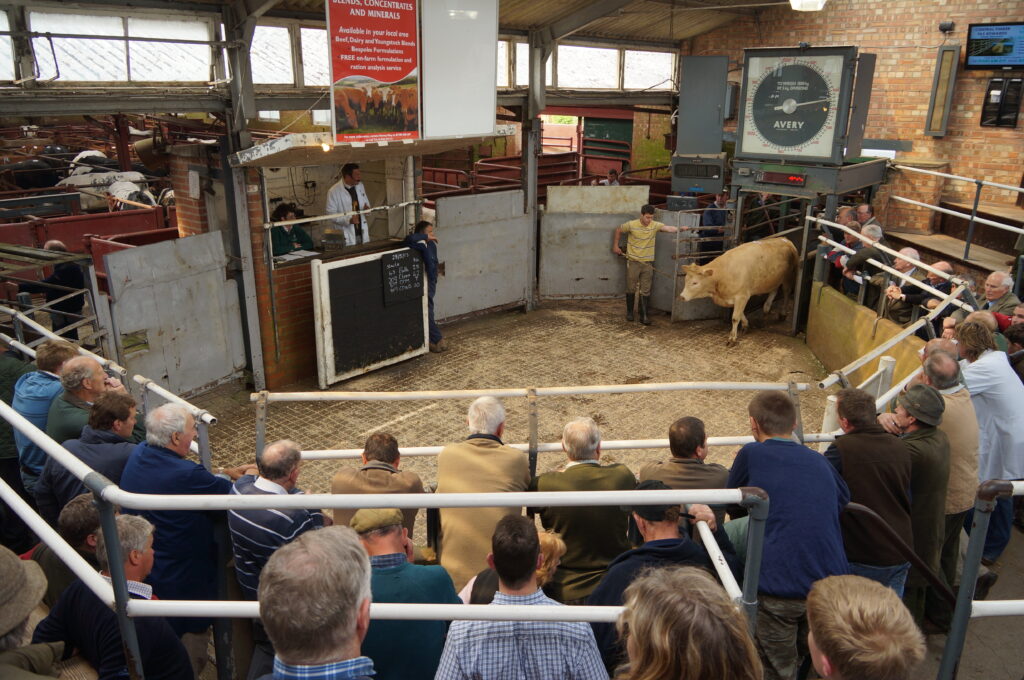
Selling Cattle
Beef cattle may be finished (reach the best weight for slaughter) inside over their second winter at around 18 months of age, or turned out to finish on grass during their second summer. These cattle are slaughtered any where from 18 – 30 months old at a weight of 450 – 550 Kg.
The farmer will weigh his cattle regularly to see if they are up to the correct weight – experienced farmers will be able to judge the weight just by looking at the cattle. When they are heavy enough they will be sold for slaughter. Some farmers take their cattle to a local market where they are bid for by people wanting beef eg butchers or super markets. Some farmers will sell their animals dead weight which mean they agree a price per kilogramme of carcass with a butcher or super market. The animal is then slaughtered and weighed to work out how much the farmer is to be paid. Some butchers like Mr Laverack prefer to buy their cattle direct from a local farmer whose cattle they know will be ideal for their customers.
The video shows cattle being sold in a livestock market and then a carcass being butchered in to the joints and cuts you buy in the shop.
Beef Production Systems.
Breeds of Cattle
Beef Breeds
- Traditional English Breeds
- Aberdeen Angus
- Hereford
- Continental Breeds
- Charolais
- Limousin
- Simmental
Dairy Breeds
- Freisian
- Holstein
Beef from Dairy Herds.
In order to continue the dairy farmer must breed replacments for his cows, he does this by mating his Holstein dairy breed cows with Holstein bulls, usually by A. I. (artificial insemination).
This provides him with cows to choose his replacments from, but also with bulls he has no use for plus some surplus cows, which are unsuitable for replacments. These surplus pure Holstein cattle are reared for beef.
The dairy farmer may also mate some of his cows with a beef breed such as: Charloais or Limousin. These beef bulls will have come from the suckler herd.
Some of the female offspring from this mating will be cross-breed cows which may be bought by the suckler herd. These cows will be mated with a beef bull to produce ideal beef cattle. In addition they will have the benefit of being part Holstein with a better milk yeild for suckling than pure beef cows.
Beef from Suckler Cows.
Beef suckler herds rear cattle purely for beef. The cow produces a calf each year which she suckles until it is weaned at around 6 months old. They use beef breeds – some may be cross-breeds, from the dairy herd as expalined above, or crossed beef breeds.
Some maybe pure breeds such as: Charolais, Limousin, Aberdeen Angus, Belgian Blue. Some of the bull calves wil be used in the dairy herd for crosing with some of the cows which they don’t want to breed replacment milking cows from.
An efficient system.
The recent BBC series ‘The Future of Food’ discussed how world livestock production was wasteful of our world food energy. Using grain to fatten cattle is inefficient – the programme gave an example of how the grain used to produce one large steak could be used to feed 40 people. It also gave figures for how much grain was needed on average to produce 1 Kg of different meats. It then however went on to say how UK Agriculture is something of an exception as around 80% of cattle in this country are fattened on grass and not cereals. What’s more this grass is grown on the Uplands of Britain which cannot be used for much else than to grow grass.
The UK system with it’s intimate relationship and cross over of stock between the dairy and beef sectors is biologically efficient with each sector providing stock for the other and providing more beef cattle than would otherwise be possible if the beef herd had to rear all it’s own replacements. It also allows suckler herds to be maintained on marginal land which would not be able to grow crops and is only suitable to grow timber. Those who argue that feeding crops to animals then eating the animals is not an efficient way of producing protein in a hungry world forget that cattle and sheep maintained on rangelands and in hilly and mountainous areas produce protein from soil which would not other wise contribute to human food supplies. The animals have low requirements for fossil fuels too!
Cattle can also be good for wildlife. Surprising though it may seem this is true. Much of the countryside we may consider as wild in this country is like it is due to livestock which have been kept on it over the centuries. Even the RSPB appreciate this and are using cattle to restore natural marshes – Cattle make a welcome comeback.